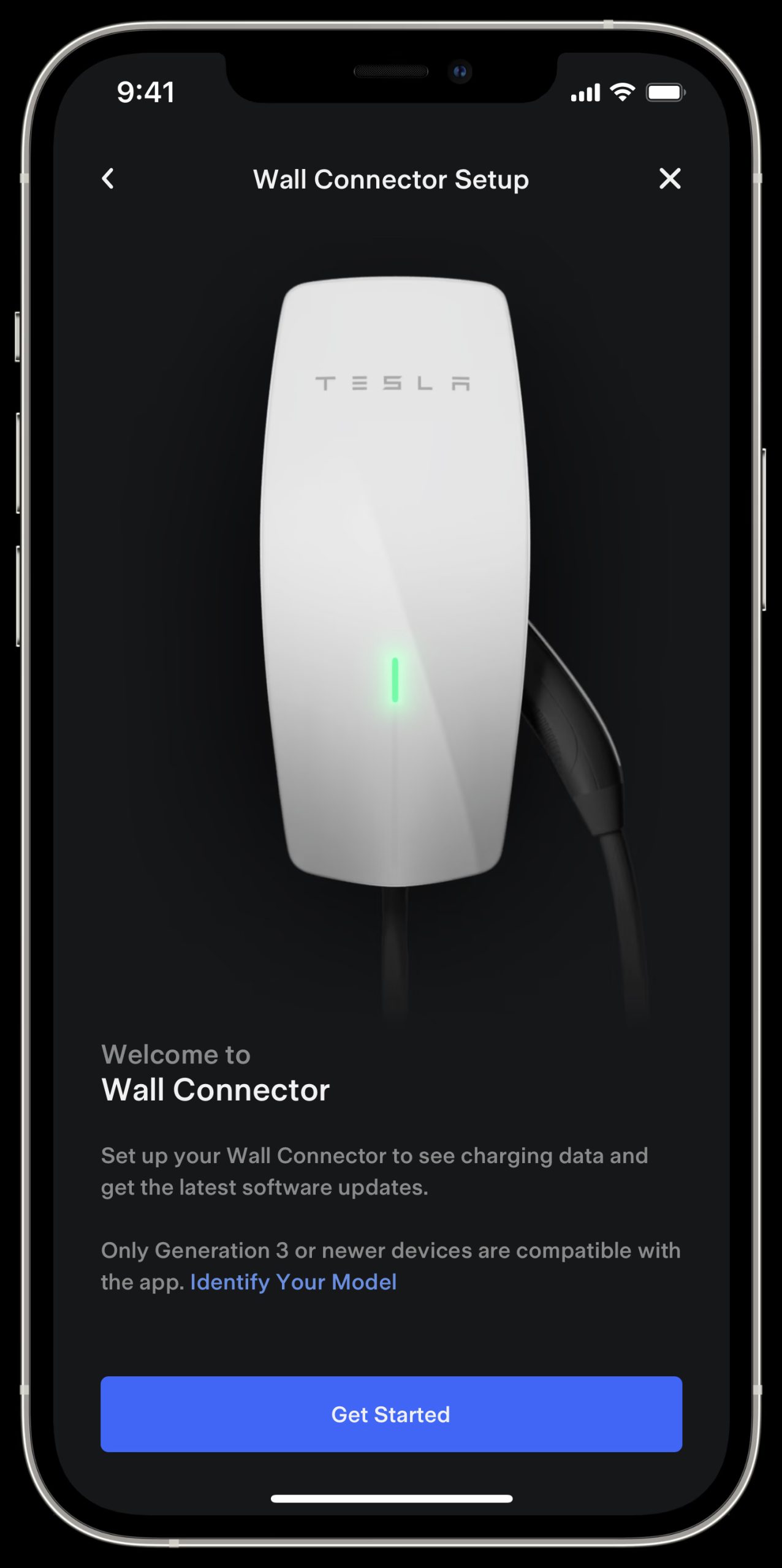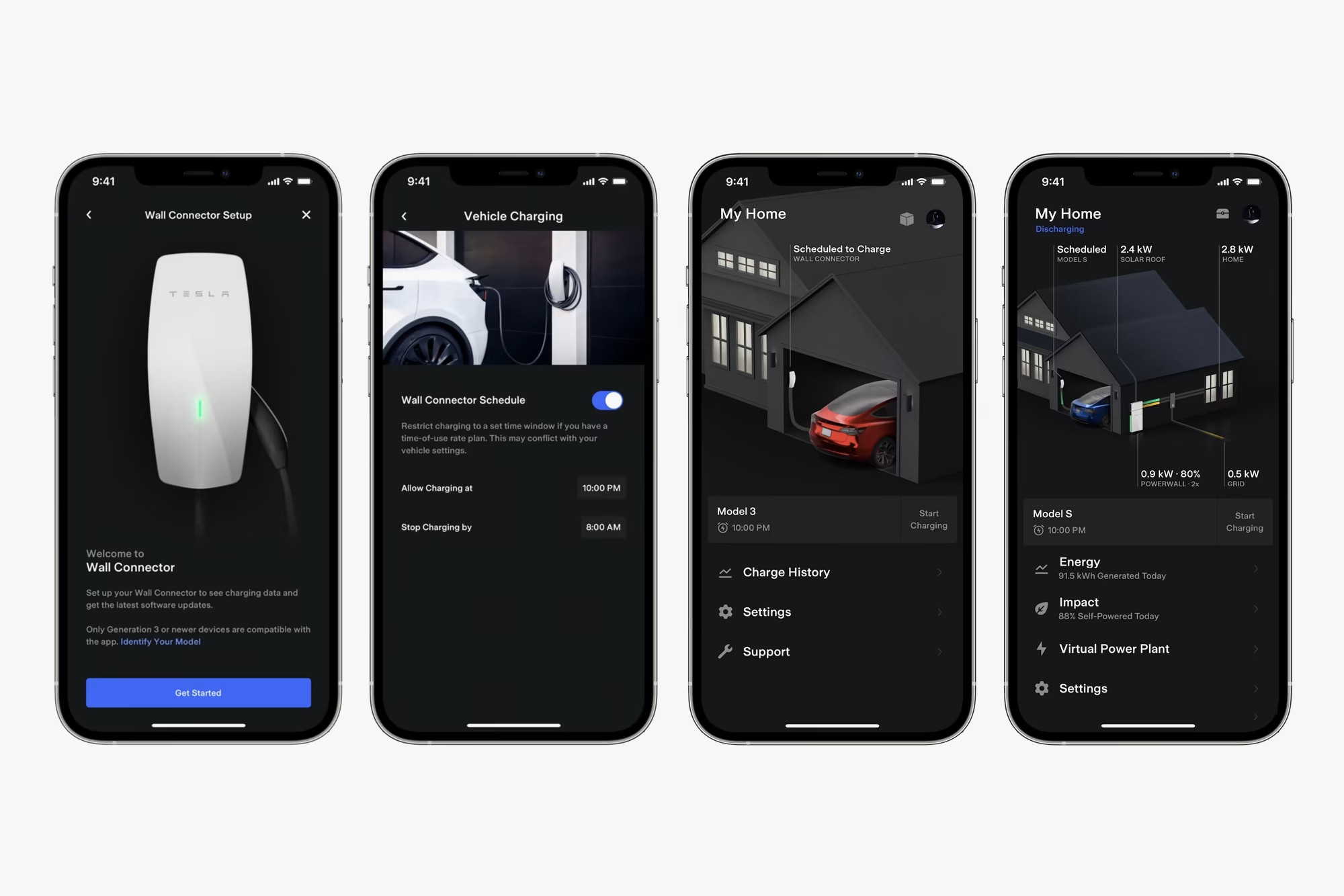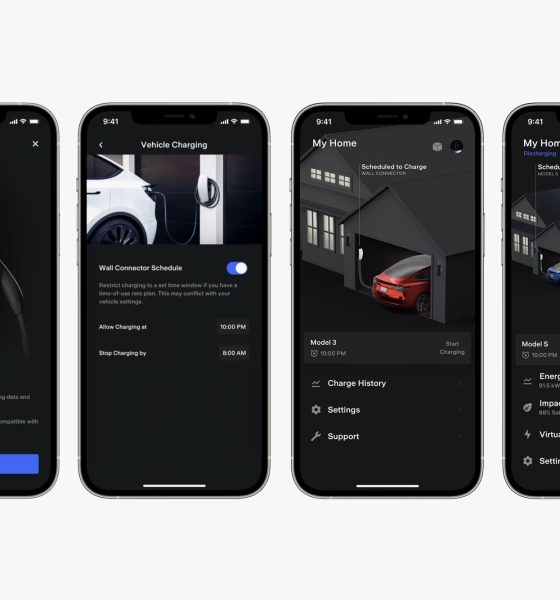Tesla seems to be preparing to add new functionality to the mobile app for managing its Wall Connector home charging equipment. With the addition, users will be able to use the Tesla app to control Wall Connector features such as a charging schedule, data about other home energy products and more.
A web page for the Tesla App for Wall Connector can be seen on the company’s website, instructing users on how to connect to the Wall Connector and showing off some of the features that will be able to be accessed through the mobile app (via electrek). Tesla’s third-generation Wall Connectors are equipped with Wi-Fi connectivity, though up to this point, they’ve offered more in the way of Destination Charging features than for home charging.
Although you can view this page on Tesla’s website, it appears that the Wall Connector settings aren’t available yet in the Tesla app for some users at the time of writing. According to some commenters, the updated functionality may only be available in certain markets, or it may not be available on Android yet — though some readers told Teslarati that they were able to access the integration in the U.S. and Canada.
It may also be only a matter of time before it’s added to the app in all major markets.
In any case, the page explains how to register a Wall Connector, saying that users should keep the app open and adding that the process could take up to five minutes. You can see Tesla’s instructions for registration below:

Credit: Tesla
- Tap your profile picture icon in the top-right corner of the app to open the profile menu.
- Tap ‘Add Product,’ and then ‘Wall Connector.’
- Follow the in-app steps to scan your Wall Connector QR code from your Quickstart Guide. You’ll need to accept a prompt to join the Wall Connector’s Wi-Fi network to continue.
Note: In case you have lost the Quickstart Guide to connect to the Wall Connector, create a support request from the Contact Support option in the Tesla app. - Connect your Wall Connector to your home Wi-Fi network and follow the remaining in-app steps to complete registration. This will allow you to see real-time charging status and continue to get the latest software updates.
Once connected to your home Wi-Fi, your Wall Connector will appear in the Tesla app for you to use.
The page also goes on to detail three major benefits of using the mobile app with the Wall Connector. These include setting up a charging schedule, viewing your charging history and looking at your home’s entire Tesla energy ecosystem.
The company also says that the Tesla app can be used to control a Wall Connector whether owners have a Tesla or a non-Tesla electric vehicle (EV). Last month, Tesla launched an updated Universal Wall Connector option that has an integrated J1772 plug and can be used to charge EVs from other automakers.
You can buy Tesla’s regular Wall Connector here for $475 or upgrade to the Universal Wall Connector here for $595. You can also read Tesla’s full web page on Wall Connector mobile app integration here.
Updated: Edited to reflect that the mobile app integration is available for at least some users in the U.S. and Canada.
What are your thoughts? Let me know at zach@teslarati.com, find me on X at @zacharyvisconti, or send your tips to us at tips@teslarati.com.

News
Tesla FSD fleet is nearing 7 billion total miles, including 2.5 billion city miles
As can be seen on Tesla’s official FSD webpage, vehicles equipped with the system have now navigated over 6.99 billion miles.

Tesla’s Full Self-Driving (Supervised) fleet is closing in on almost 7 billion total miles driven, as per data posted by the company on its official FSD webpage.
These figures hint at the massive scale of data fueling Tesla’s rapid FSD improvements, which have been quite notable as of late.
FSD mileage milestones
As can be seen on Tesla’s official FSD webpage, vehicles equipped with the system have now navigated over 6.99 billion miles. Tesla owner and avid FSD tester Whole Mars Catalog also shared a screenshot indicating that from the nearly 7 billion miles traveled by the FSD fleet, more than 2.5 billion miles were driven inside cities.
City miles are particularly valuable for complex urban scenarios like unprotected turns, pedestrian interactions, and traffic lights. This is also the difference-maker for FSD, as only complex solutions, such as Waymo’s self-driving taxis, operate similarly on inner-city streets. And even then, incidents such as the San Francisco blackouts have proven challenging for sensor-rich vehicles like Waymos.
Tesla’s data edge
Tesla has a number of advantages in the autonomous vehicle sector, one of which is the size of its fleet and the number of vehicles training FSD on real-world roads. Tesla’s nearly 7 billion FSD miles then allow the company to roll out updates that make its vehicles behave like they are being driven by experienced drivers, even if they are operating on their own.
So notable are Tesla’s improvements to FSD that NVIDIA Director of Robotics Jim Fan, after experiencing FSD v14, noted that the system is the first AI that passes what he described as a “Physical Turing Test.”
“Despite knowing exactly how robot learning works, I still find it magical watching the steering wheel turn by itself. First it feels surreal, next it becomes routine. Then, like the smartphone, taking it away actively hurts. This is how humanity gets rewired and glued to god-like technologies,” Fan wrote in a post on X.
News
Tesla starts showing how FSD will change lives in Europe
Local officials tested the system on narrow country roads and were impressed by FSD’s smooth, human-like driving, with some calling the service a game-changer for everyday life in areas that are far from urban centers.

Tesla has launched Europe’s first public shuttle service using Full Self-Driving (Supervised) in the rural Eifelkreis Bitburg-Prüm region of Germany, demonstrating how the technology can restore independence and mobility for people who struggle with limited transport options.
Local officials tested the system on narrow country roads and were impressed by FSD’s smooth, human-like driving, with some calling the service a game-changer for everyday life in areas that are far from urban centers.
Officials see real impact on rural residents
Arzfeld Mayor Johannes Kuhl and District Administrator Andreas Kruppert personally tested the Tesla shuttle service. This allowed them to see just how well FSD navigated winding lanes and rural roads confidently. Kruppert said, “Autonomous driving sounds like science fiction to many, but we simply see here that it works totally well in rural regions too.” Kuhl, for his part, also noted that FSD “feels like a very experienced driver.”
The pilot complements the area’s “Citizen Bus” program, which provides on-demand rides for elderly residents who can no longer drive themselves. Tesla Europe shared a video of a demonstration of the service, highlighting how FSD gives people their freedom back, even in places where public transport is not as prevalent.
What the Ministry for Economic Affairs and Transport says
Rhineland-Palatinate’s Minister Daniela Schmitt supported the project, praising the collaboration that made this “first of its kind in Europe” possible. As per the ministry, the rural rollout for the service shows FSD’s potential beyond major cities, and it delivers tangible benefits like grocery runs, doctor visits, and social connections for isolated residents.
“Reliable and flexible mobility is especially vital in rural areas. With the launch of a shuttle service using self-driving vehicles (FSD supervised) by Tesla in the Eifelkreis Bitburg-Prüm, an innovative pilot project is now getting underway that complements local community bus services. It is the first project of its kind in Europe.
“The result is a real gain for rural mobility: greater accessibility, more flexibility and tangible benefits for everyday life. A strong signal for innovation, cooperation and future-oriented mobility beyond urban centers,” the ministry wrote in a LinkedIn post.
News
Tesla China quietly posts Robotaxi-related job listing
Tesla China is currently seeking a Low Voltage Electrical Engineer to work on circuit board design for the company’s autonomous vehicles.

Tesla has posted a new job listing in Shanghai explicitly tied to its Robotaxi program, fueling speculation that the company is preparing to launch its dedicated autonomous ride-hailing service in China.
As noted in the listing, Tesla China is currently seeking a Low Voltage Electrical Engineer to work on circuit board design for the company’s autonomous vehicles.
Robotaxi-specific role
The listing, which was shared on social media platform X by industry watcher @tslaming, suggested that Tesla China is looking to fill the role urgently. The job listing itself specifically mentions that the person hired for the role will be working on the Low Voltage Hardware team, which would design the circuit boards that would serve as the nervous system of the Robotaxi.
Key tasks for the role, as indicated in the job listing, include collaboration with PCB layout, firmware, mechanical, program management, and validation teams, among other responsibilities. The role is based in Shanghai.
China Robotaxi launch
China represents a massive potential market for robotaxis, with its dense urban centers and supportive policies in select cities. Tesla has limited permission to roll out FSD in the country, though despite this, its vehicles have been hailed as among the best in the market when it comes to autonomous features. So far, at least, it appears that China supports Tesla’s FSD and Robotaxi rollout.
This was hinted at in November, when Tesla brought the Cybercab to the 8th China International Import Expo (CIIE) in Shanghai, marking the first time that the autonomous two-seater was brought to the Asia-Pacific region. The vehicle, despite not having a release date in China, received a significant amount of interest among the event’s attendees.










